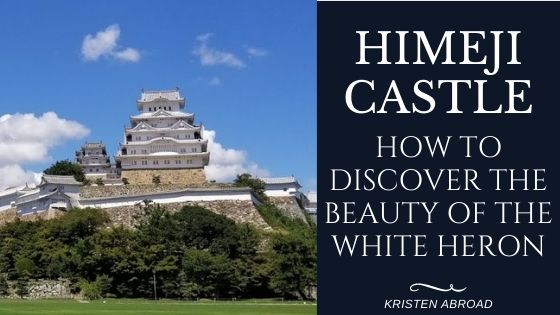Welcome to Himeji Castle 姫路城. Nicknamed the White Heron (or white egret, apparently they couldn’t decide on a white bird…) Castle for its coloring. She (are castles like ships? Female? They are now!) is the 6th in my quest to see all 12 of the original Japanese castle. Himeji castle is, in fact, the largest castle in Japan, located in Hyogo Prefecture in Himeji City.
[Editor’s Note: This post was originally published in October of 2018 and has been updated for freshness, accuracy, and comprehensiveness.]
Disclosure: Kristenabroad.com is a participant in the Amazon Services LLC Associates Program and other affiliate programs. For some links to products or services in this article, I may earn a small commission from you using my link. The price for you is not affected.
A bit of history and designations
Himeji Castle dates back to the early 1300s when it started as a fort atop the hill. Ripped down and built into a castle around 1346, it was again redone… have you been reading my castle posts in order? Yup, you guessed it. Around 1600. It was later expanded on and has remained the same for 400 years. Himeji City was burned to the ground during WWII but the castle survived. She also survived some really massive earthquakes. Most importantly, she didn’t get ripped down during the Meiji period as so many castles did.
Of the 83 buildings that make up the castle grounds, 74 are designated as Important Cultural Assets. SEVENTY FOUR! That’s insane. The other castles maxed out at 11 or so. That equates to 11 corridors, 16 turrets, 15 gates, and 32 earthen walls. Himeji Castle is not just an important cultural property though, it’s also a UNESCO world heritage site which was designated in 1993. Japan’s first. Translation: Himeji Castle is Japan’s most visited Japanese castle. With good reason!
And remember, that’s 83 buildings that are still existing at Himeji Castle. There used to be so many more!
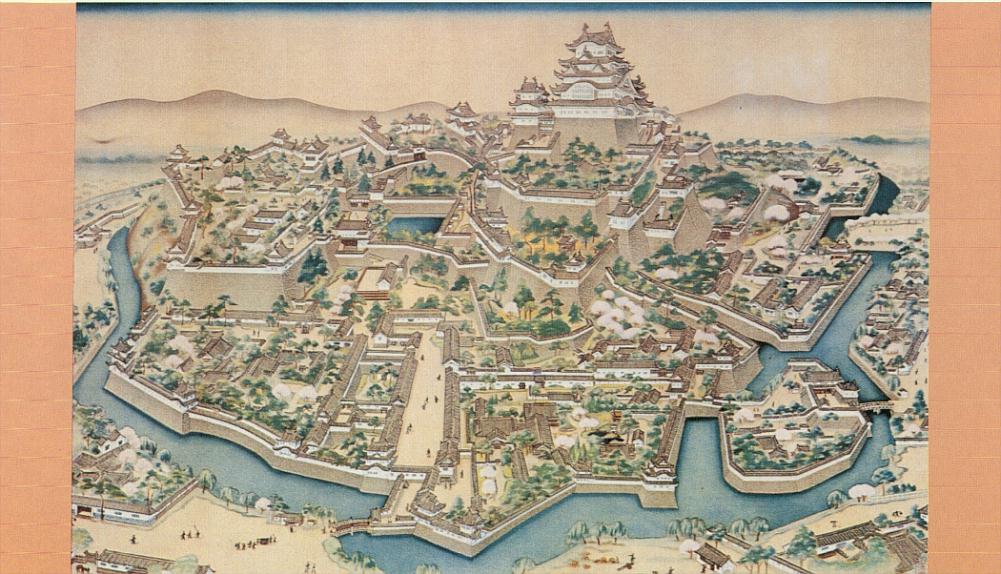
The approach to Himeji Castle
Himeji Castle awes you the second you pull into Himeji Station. Generally speaking, when I get off the train somewhere, I’m trying to figure out which exit to leave from. Not necessary here. Straight view of the castle as soon as we pulled in on the shinkansen.
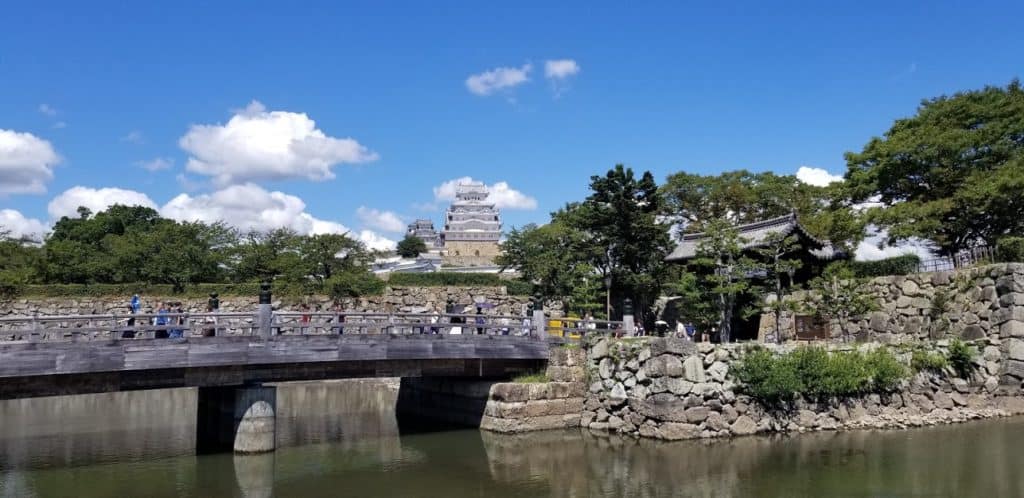
Once you walk up the street from the station (or there are buses), you’ll come to this bridge and gate. The gate is called Sakuramon, so the bridge is Sakuramon bashi (bashi is the Japanese word for bridge). With the castle looming in the background, it’s a beautiful sight.
The moat? If you are visiting on the weekends, there are boat trips you can take along in. There aren’t very many though so get your tickets early.
Bring your walking shoes for this one (I love my Teva sandals for travel). The overall castle is nearly a mile at the widest points in each direction.
The Main Keep
Unlike Kochi Castle, Himeji Castle’s main keep is all about the military function. You have to remember with Japanese Castle keep’s that the tiers don’t always match the floors. So whereas from the outside it looks like five tiers, the inside has a basement and six floors – lots of stairs to climb! If you were an invading army, there are all sorts of defenses INSIDE as well as the fact that you had to make it all the way to the keep in the first place! 武者隠し (
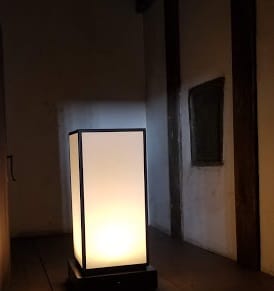
There were also platforms on some of the floor that I originally thought someone must stand on to give a speech or something. The ceilings were super high, seemed to make sense. In actuality, they are so that people could throw rocks out the windows at invading armies. Don’t forget the death holes for shooting guns and arrows. (Actual name is loophole).
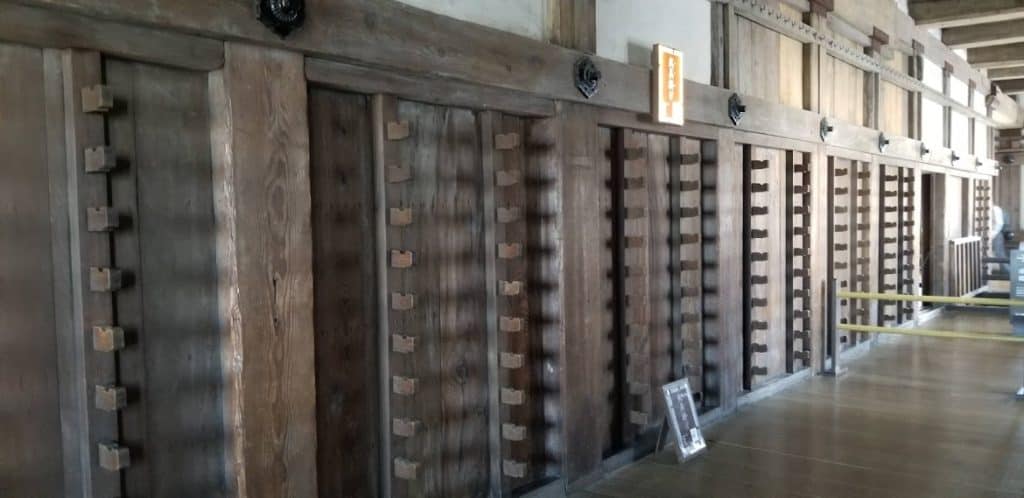
When you go inside, you’ll take off your shoes and carry them with you. They give you plastic bags to use as you’ll leave at a different spot than you came in at. The stairs that you walk up to enter the castle have, of course, been there forever and there’s a sign to call your attention to the fact that samurai and lords have walked up them barefoot just like you. Kind of fun.
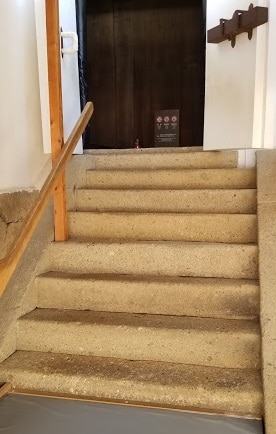
The first floor is nearly 6000 sq. ft. (?!?!?) with follow on floors slowly getting smaller until the top floor is “only” 1240 sq. ft. That’s twice as big as most people’s apartments in Japan! You’ll get to walk through the whole thing. Its’ really neat with the lighting they have throughout. It’s also surprising how tall the ceilings are. The whole keep is just over 150 feet tall. The fact that they were able to make such a structure with just wood is amazing to me.
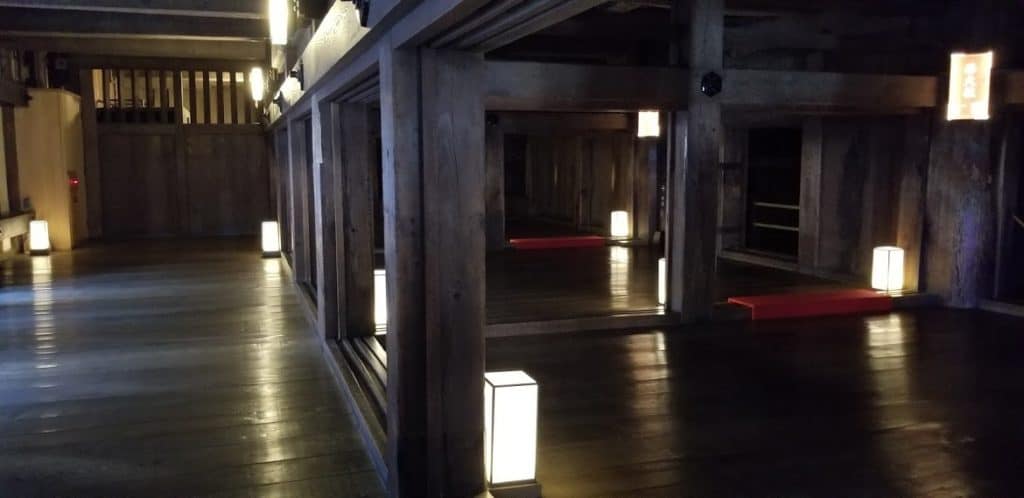
The Princesses Bailey
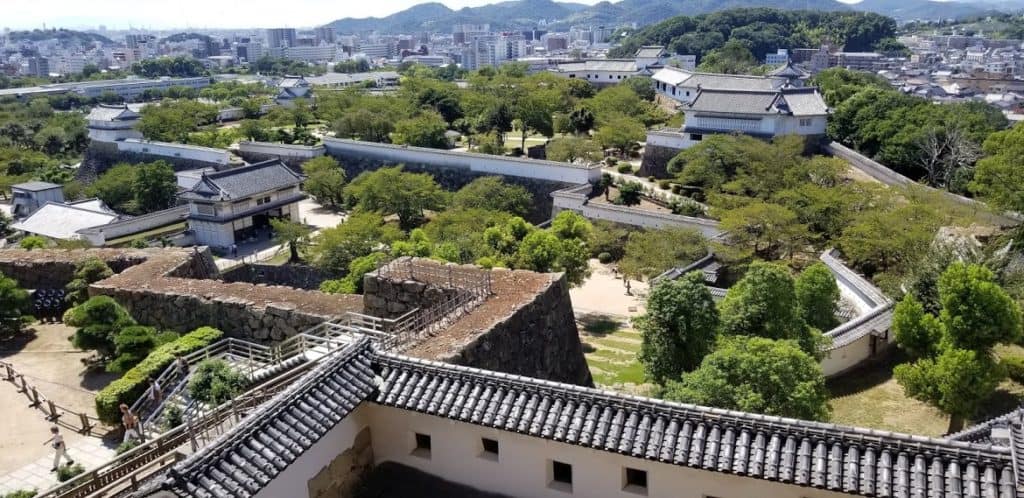
Sadly, the palaces are no longer in existence. Neither the main palace for the Lord or the one he made when his daughter married. If you want to see a palace, head to the Imperial Palace in Kyoto, Nijo Castle, Kawagoe Castle, Kakegawa Castle, or Nagoya Castle (though that one is a reconstruction). There’s also an imperial villa in Nikko. You can still see the long corridors that made up the princess servant’s living quarters though. These are incorporated into the walls protecting the palace. The princess also had her own quarters as a “retreat” or some such at the end of the corridors and this still is there.
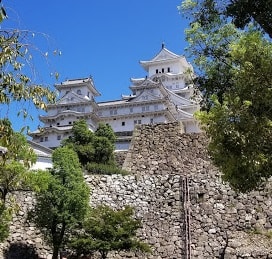
How Much time do you need for Himeji Castle?
Give yourself at least 2 hours if it’s not busy, but lean towards a half day. Probably more if it’s busy. There is so much to see! During Cherry Blossom season they limit the number of tickets to 15,000 so be wary of that too. And because they get so busy, it’s like Disney, where they give you wait times to the ticket counter and the castle keep! If you get there late in the day and there are long waits, keep in mind that your ticket is only valid for the day you purchased it.
Also you can only purchase tickets to Himeji Castle at the ticket counter the day of visit. Tickets for Himeji Castle are 1,000 yen for adults at the time of writing this. You can add on the neighboring Japanese garden for 40 yen more!
One of the times I was at Himeji during the summer. It can be brutally hot, and with such large grounds to walk around in broad sunlight, please make sure that you have ample water supply. Luckily it’s Japan and you can find vending machines all over. But, seriously, drink up, lots of people were getting heatstroke that day!
Part of the reason you should stay in Himeji the whole day, is for the beautiful night views of Himeji Castle. Stop by an izakaya and then see it after dark. The paid portion of the grounds closes around 5 pm but you can see the unpaid version later. At different times of the year they have events there.
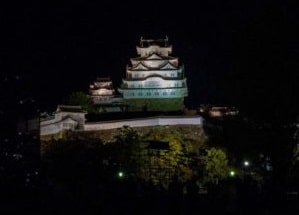
Getting your Castle Stamp
Don’t forget your stamp for the 100 finest castles while you are here! The 100 Famous Castles in Japan (日本百名城, Nihon Hyaku Meijyou) were chosen by the Japan Castle Foundation (日本城郭協会, Nihon Jōkaku Kyōkai) and include castles all over the country, including the 12 originals.
The stamps make for a fun souvenir as well as a record of all the castles you have been to. There is a guidebook that you can get to keep them in (and turn them in for a prize if you get them all!).
How to get to Himeji Castle
From any of the big tourist spots (Tokyo, Osaka, Kyoto) it is an easy shinkansen ride to get to Himeji, I love all trains in Japan! From Shin Osaka Station to Himeji Station take the Hikari Shinkansen in around 35 minutes. Taking the JR Tokaido/Sanyo Shinkansen from Kyoto to Himeji takes about an hour.
The longest is going to be from Tokyo. If you can take the Nozomi shinkansen, from Tokyo to Himeji is 3 hours. On the JR Rail Pass? It’ll be about 3.5-4 hours. I’d suggest going straight there and then making your way back to other sites in Kyoto and Osaka (if you are doing the “main circuit” as I like to call it). Or keep going from Himeji to some of the other 12 original castles of Japan. I’ll be working on full itinerary options for this soon! Make sure to sign up for the newsletter to keep posted.
The view from the shinkansen platform of the lead into the castle is very unique. You’ll take the north exit and it’s about a 1 km walk to get to Sakuramon bridge to get into the castle complex. Speaking of, there are tons of paths and parks around the castle to track your steps.
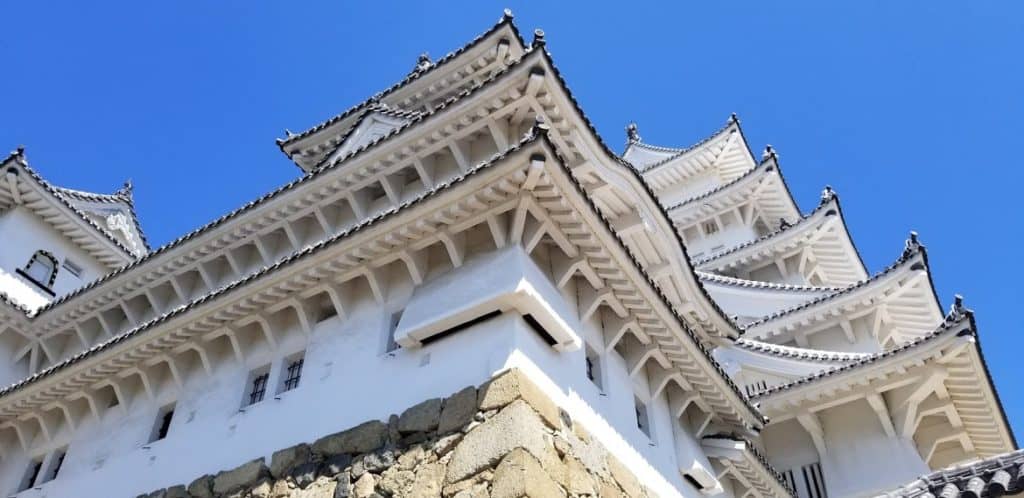
Is Himeji Castle Worth it?
Yes! Especially if you are interested in Japanese history and of course, Japanese castles. I will say though Himeji Castle is amazing, she’s not my favorite. Matsuyama Castle in Shikoku still holds that one. Sometimes the crowds are right but it’s important to stick to your guns if you have a differing opinion. That’s what makes the world interesting.
All that said, please, if you are only in Japan for a little while, go see Himeji Castle. You won’t be disappointed.
What is there to do near Himeji Castle?
One the castle grounds, you can visit the Edo period-style Kokoen gardens. You can get a combined entrance pass for both the castle and the gardens, adding the Japanese Gardens is all of 40 yen more! While not one of the top three gardens like the one in Okayama, they are beautiful nonetheless! In fact, Japanese gardens are very often a nice side quest to Japanese castles.
If you decide to walk to the castle, you can approach down the main drag, Otemae Street (which has lots of statues – Japan loves statues) or the Himeji Ekimae shopping street (with an arcade). Great way to keep out of the sun on those hot days but also good if it is raining!
Have you tried the rather simplistic but super delicious Japanese food, 玉かけめし (Tamakakemeshi or sometimes as tamakakegohan)? It’s a raw (don’t worry, they are safe!) egg on top of warm rice. Don’t knock it till you try it. Tamagoya across from the Sakuramon bridge has it. There is also a Cremia stand there in the summer, the best soft serve I’ve found in Japan.
While you are in Hyogo Prefecture, don’t forget to head over to Kobe for some Kobe Beef.

